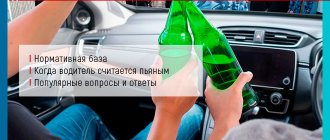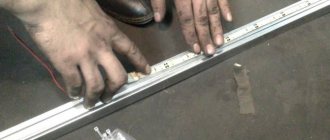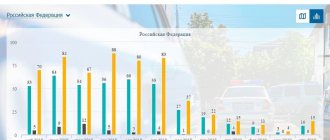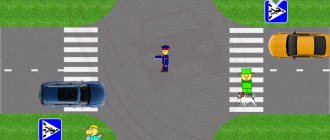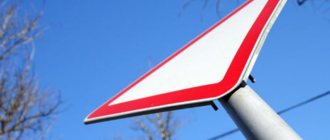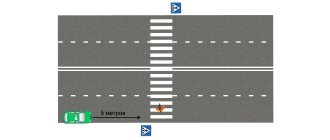How much are the new fines for downed animals? Table
The most important mistake of our time among car enthusiasts is that many consider the payment for a downed animal on the road to be a traffic police fine. This is not true - in fact, it is a payment to compensate for the damage caused.
Payment of a tax for a downed animal in Russia is separate from the traffic police fine as compensation for damage. A fine is assigned for a specific traffic violation. However, most often drivers are accused of failing to comply with the requirement of paragraph 10.1 of the Rules (incorrectly chosen speed, which did not allow monitoring the road situation), and for its violation there are simply no sanctions in the 2021 Code of Administrative Offenses of the Russian Federation.
So now let's take a look at the size of the new increased sanctions. They actually increased not so long ago, and their amounts became approximately 2 times higher than they were before.
These rates are established by the relevant Order of the Ministry of Natural Resources, Appendix No. 1 of the document.
Table of fines for hitting wild animals
| What kind of downed animal? | Amount of fine |
| Elk, musk ox or Siberian mountain goat | 80 000 |
| Wild boar, reindeer or musk deer | 30 000 |
| Noble deer | 70 000 |
| Sika deer, fallow deer, aurochs or saiga | 60 000 |
| Roe deer, mouflon or chamois | 40 000 |
| bighorn sheep | 100 000 |
| Hybrid of bison and bison or with livestock | 180 000 |
| Bear | 60 000 |
| Badger | 12 000 |
| Marmot, beaver, marten or harza | 6 000 |
| Sable, wolverine or otter | 15 000 |
| Lynx | 40 000 |
| Wolf, fox, jackal, raccoon or raccoon dog | 200 |
| Arctic fox, corsac fox, wild cat, mink, wild rabbit or hare | 1 000 |
| Ermine, solongoi, weasel, muskrat, ferret, weasel, squirrel or chipmunk | 500 |
| Mole, water vole, hamster, chipmunk or gopher | 100 |
| Capercaillie | 6 000 |
| Grouse, pheasant, snowcock or sajja | 2 000 |
| Goose or goose | 1 000 |
| Duck, hazel grouse, partridge, chukar, pigeon, coot or woodcock | 600 |
| Quail, rail, common crake, corncrake, moorhen, lapwing, tules, snapper, turnstone, ruff, grasshopper, snail, morodunka, godwit, curlew, snipe, great snipe, greenhorn, turtle dove | 200 |
We also have a special article on the downed elk situation.
Increased sanctions for animals from the Red Book
Please note, according to Appendix No. 2 of the Order of the Ministry of Nature of Russia, if an animal is listed in the Red Book of a constituent entity of the Russian Federation, then the fine for it will be increased by a factor of 5 or even 7.
The subject in this case means the region of Russia. For example, roe deer, sika deer and others may not be in the Red Book in the Moscow region, but be listed as endangered in the northern regions. Therefore, if you shoot down a wild animal in a specific region, an increased coefficient may be applied - that is, the fine will be 5 or 7 times higher:
- if you hit a male wild animal - coefficient 5,
- if it is a female – and, regardless of whether she is pregnant or not – 7.
In addition, in the table of fines above, animals can be shown simply in a generalized form. But the driver may run over a rare subspecies of animal.
Let's give an example. The driver was driving along the highway and hit a special red wolf in the Kaliningrad region. Since the animal is in the Red Book, the fine for it will be increased. If it was a male wolf - 1,000 rubles (instead of 200), and if it was a she-wolf - 1,400 rubles.
You will also be interested in:
- Hit a moose - all the details of an accident and what is the fine?
- Increasing the fine for driving without compulsory motor liability insurance to 5,000 rubles from January 1, 2021 - true or false?
- Bus lane according to traffic rules and fines for driving and stopping on it in questions and answers
If it's not your fault?
We found out above that for hitting an animal, you pay not a fine, but compensation for damage. But who is harmed in this case? Of course, to the state - if we are talking about a wild animal.
The fact is that all animals in nature legally belong to the state. Does this mean that the latter is obliged to monitor them so that they do not go out on the roads? Does this mean that if they didn’t follow up, then the state bears responsibility? Alas, no – and to both questions!
The judicial practice that has developed in 2021 directly speaks to this. The arguments of the courts in the event of an attempt to appeal a fine for running down an animal are almost always the same:
It is not possible to control or even track the movement of wild animals. Therefore, no government agency or institution can be held responsible for their movement, including access to the roads. At the same time, the driver, when driving along roads outside populated areas, is obliged to anticipate the possible exit of an animal from a forest belt or similar area of nature.
Here is an example of one of these court decisions.
Thus, almost always in the case of a collision with a wild animal, the driver of the vehicle is guilty of such an accident.
Expert opinion
Yuri Panchenko
Driving instructor, human rights activist, author of books. 10 years of experience.
The speed of information transfer from the eyes to the brain is small, designed for the speed of a running person. When information is received from the eyes, consciousness also uses memory to form a picture about the world around us. Obtaining the result of information processing takes a certain time, during which the car manages to travel some distance. And information from the periphery of vision becomes irrelevant.
As a result, consciousness ceases to perceive what is happening to the right and left of the road. At a speed of 120 km/h, the driver sees only his own lane in front of him. And, for example, the driver no longer sees a car that is closer than 40 m in the oncoming lane.
The appearance of an animal in the field of view of a driver who is moving at high speed is always unexpected.
Why do the "Cattle Driving" and "Wild Animals" signs show a cow and a moose? Their legs are thin, their center of gravity is high, and their mass is large. When a car hits their legs at high speed, the carcass of an animal weighing several hundred kilograms flies into the windshield with the most tragic consequences...
Ask a Question
Animals on the road: who is responsible for an accident?
Road accidents involving animals are not uncommon. Almost every driver sooner or later had to meet four-legged pedestrians on his way at any time of the year. The consequences of such a meeting are different, and so are the circumstances. In which cases the driver is to blame, and in which he can be released from liability, the correspondent of the North-Western Legal Examined.
Our editor received a letter from a resident of the village of Krasnaya Bashkiria, in which she talks about one of the main problems on roads in rural areas. “In Bashkiria they really love to breed horses,” writes Dilya Yakupova. – People are dying due to cars hitting horses. But after the accident, the owners do not recognize the animals. They won’t agree to pay for broken cars!”
Unfortunately, accidents with animals are not at all harmless, and the driver himself, as well as his car, can suffer. In this case, material damage may be covered by insurance. However, it should be remembered that MTPL payments are not provided in such cases.
“There can only be one piece of advice for motorists: CASCO insurance is required. If it is, then there will be no problems at all. A special service goes to the scene of the incident, documents are drawn up for subsequent compensation for material damage,” says the chairman of the All-Russian Society of Motorists (SAA) Valery Soldunov .
It is much more difficult to collect money from animal owners, but it is also possible. And this happens in court.
“If you go to court, you will need a set of documents indicating the assessment of damage to the vehicle that was involved in the accident. Therefore, the emergency service or traffic police, which are located in this locality, must be called to the scene of the accident in order to record the fact of the accident and the severity of the consequences after it,” explains Valery Soldunov .
The expert also reminds that at the entrance to a populated area where livestock is raised, as a rule, there are corresponding signs. And the driver must pay close attention to this. If a motorist exceeds the speed limit or ignores the “Cattle Driving” warning sign, he will be found guilty of a traffic accident and will bear administrative liability.
But sometimes animals jump onto the roadway so quickly that it is impossible to prevent an accident. Will this situation be considered a traffic violation if the driver did not attempt to brake?
“As for violating traffic rules, this is a controversial issue. According to paragraph 2 of clause 10.1 of the Traffic Rules, approved by Decree of the Council of Ministers - Government of the Russian Federation of October 23, 1993 No. 1090: “If a danger to traffic arises that the driver is able to detect, he must take possible measures to reduce the speed down to stopping the vehicle."
Those. Traffic regulations require the driver to slow down. At the same time, the driver must act in such a way that the damage is minimal.
An animal, unlike a person, moves faster and can suddenly jump onto the road.
The distance and speed of the animal may not allow the driver to prevent a collision by braking. In addition, other vehicles may be driving behind the vehicle and in parallel with it. Sharp braking can lead to an accident with a vehicle moving behind; going sharply to the side means creating an emergency situation, which can result in an accident with a car moving in parallel,” Evelina Trofimovich, a lawyer at the SZPC “Man and Law,” .
If the driver can prove that he was not to blame for what happened, and the animal suddenly ran out onto the road, then he will be released from liability.
But if the motorist left the scene of the accident, and this fact was recorded by eyewitnesses (for example, the owner of the downed animal), then the driver will not be able to avoid administrative punishment. According to Part 2 of Article 12.27 of the Code of Administrative Offenses, for leaving the scene of an accident, he will receive administrative arrest for up to 15 days or deprivation of rights for 1 - 1.5 years.
If the driver unquestioningly followed the traffic rules, then he may be recognized as a victim in an accident. If there is damage to the car, the owner of the animal will have to pay for the material damage to the car owner. But how to find this owner?
“It is necessary to make inquiries to the responsible organizations - the veterinary department and the department for the development of livestock farming, fur farming and poultry farming under the regional administration committee. Through the administration, contact those who had the animal parked. The former owners will already lead you to the person who owned the animal,” advises lawyer Tatyana Prokhorova .
The owner of the animal can also demand compensation. As Article 1079 of the Civil Code states, “citizens are obliged to compensate for damage caused by a source of increased danger,” which is a car.
By the way, the driver will bear civil liability if he hits a wild animal. In this case, the owner is the state. The cost of damage for a downed forest dweller varies from 50 to 90,000 rubles.
Unfortunately, it is impossible to teach animals to cross the road in the right place. But minimizing the likelihood of accidents on the highways involving “our little brothers” largely depends on ourselves. Both motorists and animal owners should remember this.
Anastasia Verbitskaya Photo: NWPC “Man and Law”
Were there any changes in 2021?
No. Despite the fact that fines for downed wild animals are called new, they are relatively so. Because the latest changes in the corresponding table of compensation rates for animals came into force in February 2021, and not in 2021 at all.
But the truth is that these fines then doubled for almost all animals. For example, if previously you would have paid 15 thousand rubles for a downed wild boar, today you will be forced to pay 30 thousand. And the maximum established fine is various bison hybrids - 180,000 rubles.
Let's take a comparative look at the amendments to increase sanctions for accidents involving the most common living creatures on Russian roads.
Comparative table of changes in fines for downed animals
| Animal | Old fine | New fine |
| Elk | 40 000 | 80 000 |
| Wild boar, reindeer | 15 000 | 30 000 |
| Roe | 20 000 | 40 000 |
| Bear | 30 000 | 60 000 |
| Beaver, marten | 3 000 | 6 000 |
| Lynx | 20 000 | 40 000 |
| Wolf, fox | 100 | 200 |
| Arctic fox, mink, hare | 500 | 1 000 |
| Ferret, muskrat | 500 | 500 |
| Weasel | 200 | 500 |
| Chipmunk | 50 | 500 |
| Mole | 50 | 100 |
| Duck, partridge pigeon | 300 | 600 |
As you can see, most fines have doubled, with the exception of some animals (weasel, chipmunk).
Hit an animal with a car, what's the danger?
A collision with an animal, of any size, is classified as an accident and faces a fine. We are talking about an accident with serious injury to an animal or death. That is, if a car hits an animal, the driver is obliged according to the rules to stop, turn on the emergency lights, put up an emergency stop sign and report to the traffic police about the accident.
If the prescribed actions are not followed and the driver continues to drive after the collision, the driver’s actions can be classified as leaving the scene of an accident. And such an offense entails serious consequences in the form of deprivation of rights from one to one and a half years or arrest for up to 15 days.
Judicial practice indicates an increase in claims related to downed animals. Registration of cars passing by on recorders helps to prove the guilt of the motorist and impose fines on them. Proper registration of an accident involving an animal will help you avoid punishment. The fine will still have to be paid, but the license will remain with the motorist.
Fine for hitting an animal in 2018
The legislation of the Russian Federation clearly delineates financial responsibility, in the form of a fine, for a downed animal, depending on its size and value for the owner. The owner can be a private person or a legal entity. The ratio of the size of the beast to the size of the fine:
- Small rodents – 50 rubles;
- Small wild animals and birds (fox, wolf, raccoon, muskrat, hares, black grouse, etc.) - fines range from 100 to 1,000 rubles;
- Otter, sable – 5,000 rubles;
- Badger – 6,000 rubles;
- Deer, wild boars, bears, etc. - from 15,000 to 35,000 rubles;
- Elk, musk ox, mountain goat – 40,000 rubles;
- Snow sheep - 50,000 rubles;
- Bison, bison or their hybrids – 90,000 rub.
The amount of damage from the death of a wild animal in an accident is calculated based on the value that it could bring to forestry - fur, meat, offspring, etc., as well as on the uniqueness of the animal for the fauna of the country and continent.
What is the fine for an Amur tiger?
The paradox of the legislation is that the above table of fines for downed animals does not include one of the most endangered species living in Russia - the Amur tiger, as well as any other subspecies of tigers.
Meanwhile, in some old and recent news you can find information that the prosecutor’s office opened a case for allegedly shooting down a tiger and assessed the animal. But there are no legal grounds for such recovery of an animal that is in the Red Book, but the amount of damage for which is not established in regulations, in terms of determining the amount of compensation for damage. Although, since the damage was still caused, it is subject to compensation by law.
Insurance
OSAGO will help only in the following cases:
- The owner was at the scene of the accident , and you called the traffic police. All that remains is to prove that the animal for some reason crossed the road without its owner and was not wearing a leash. In this case, in the absence of evidence of other violations, rest assured that all responsibility will fall on the owner .
- You hit a cow (or goat) that suddenly appeared on the roadway outside the coverage area of the “Livestock” . In this situation, you only need to call the traffic police and determine which farm the dead (or injured) animal belonged to. The owner will have to bear responsibility for the fact that the animal ended up on the road unattended. In other cases, you can consider yourself lucky in only one case - if you have CASCO insurance, with a written clause stating that you are entitled to compensation in case of an accident involving animals.
But what if the driver is at fault for the accident? In a situation with a dog, in this case, try to resolve the issue peacefully. Take the injured dog and its owner to the veterinary clinic and pay for all treatment . But keep in mind that the owner has every right to sue you.
There is no law directly protecting the lives of pets in our country, but there is such a thing as “private property” . The same applies to the situation with downed livestock - if you are at fault, you will have to pay the owners the amount of damage caused to them, that is, the cost of the animal.
Pet owners have a responsibility to ensure the safety of their pets and others. Therefore, they are allowed to walk only on a leash and muzzle, and their grazing must be done in special places and under the supervision of a shepherd.
Is there a sanction for a pigeon, hedgehog, fox and other small animals?
There are also a number of animals that very often run out onto the road from forests and fields. However, not all of them are subject to sanctions.
For example, for the following animals the fee is fixed by the above Order of the Ministry of Natural Resources:
- fox – 200 rubles,
- pigeon – 600 rubles,
- gopher – 100 rubles,
- elk – 80,000 rubles,
- wild boar – 30,000 rubles,
- hare – 1,000 rubles.
Please note that the fine for an ordinary pigeon is 3 times higher than for a downed fox.
And the following animals “can be shot down for free”:
- an ordinary mouse (only for a water vole there will be a fine of 100 rubles),
- hedgehog,
- all types of snakes.
Wild penalties
Police officers will initiate an administrative case. As a rule, those responsible for road accidents are punished for related violations, such as speeding, says lawyer Dmitry Bezdelin. There is no separate liability for a downed animal provided for by law.
Drivers' liability for traffic violations will be increased
Road deaths should reach zero by 2030
Meanwhile, the driver will still have to pay a fine issued by the forestry employee on whose territory the accident occurred. He is issued for material damage to state property, since wild animals are the property of the state. For example, you will have to pay 200 rubles for a downed fox, 30 thousand for a wild boar, and 80 thousand rubles for a moose. An exotic bison will cost 180 thousand rubles.
The amount of the fine is fixed, but the managing partner of the Zharov Group, lawyer Evgeny Zharov, cites as an example the decision of the Lipetsk City Court, which fined the driver who hit a moose cow 175 thousand rubles. The amount of the fine included damage from the death of future moose calves, which this 4-year-old female moose could still give birth to.
What is the penalty for a dog, cat or chicken?
But for pets, a fine is much less likely. The fact is that if wild animals are the property of the state, and the judicial practice of 2021 established that there is no obligation to monitor them, as well as to be responsible for them, then for domestic animals the responsibility is assigned to their owners.
Thus, if a driver hits a domestic dog, cat, cow, calf, bull, horse, or even a chicken, duck, or goose that has an owner, then the owner may be liable for compensation. But do not forget that Article 1079 of the Civil Code of the Russian Federation also applies here, prescribing driving a car as a source of increased danger and the obligation to compensate for harm, regardless of the presence of fault in an accident with an animal.
Although, according to the Civil Code, a pet is property.
Will insurance cover MTPL?
The good news for motorists who have been involved in a collision with a wild animal is that, other things being equal, the MTPL agreement covers damage caused by the vehicle to this animal.
Since the current liability limit in 2021 is 400 thousand rubles, all animals in the table above without exception are subject to full compensation.
Something else useful for you:
- What are the fines for driving without paying on a toll road? New law on non-payment of toll sections
- New traffic police fines and changes to traffic rules from March 1 and 20 - true or false?
- New fine for stopping and parking on the lawn - true or not?
How to behave
If you hit a dog with a car, what should you do in this situation? To begin to answer, you must first find out what the law says on this matter. Meanwhile, the law states that any collision that occurs on the roadway is considered to be an accident . That is, if a dog gets hurt on your bumper while you are parked, it’s not your problem . But as soon as you run into her, the responsibility for your four-legged friend and for the incident is yours.
By the way, it’s not just about dogs. On the trails, for example, it is not uncommon to encounter a fox, a hare, a wild boar, or even a deer or elk. A meeting with the latter, by the way, promises critical damage not only to the car. You need to be extremely careful on the highway at night, especially when you see a sign warning about the possible appearance of an animal on the road.
In view of the fact that often an accident cannot be avoided due to the small size of the animals, which does not allow them to be constantly visible, we recommend that you follow the following procedure:
- First of all, stop the car and turn on the hazard lights to notify other road users about the accident.
- Put up an emergency sign . Let us remind you that if you hit a pet and this happened in the city, the sign must be placed at a distance of 15 meters . If you hit a wild animal, that is, on the highway, you must place a sign 30 meters away .
- Check the condition of the four-legged one . If a cat or dog was hit, look around - perhaps there are owners somewhere nearby. If the animal is alive, take it to a veterinary clinic (if possible). Don't be afraid to get your car dirty! Someone's life is worth more than dry cleaning. Besides, perhaps this life is very dear to someone. If the animal dies on the spot, move the body to the side of the road or to a place where it will not be subject to a second collision.
- If you hit a dog and the owner is found, call the traffic police . If the owners are not present, we recommend taking photographs of the scene of the incident.
Regardless of the circumstances, call the police . Servants of the law must also record everything and take into account all factors. Next, they will have to make a decision on who is to blame.
Of course, if you hit a wild animal outside the coverage area of the warning sign, there will be no one to compensate for the losses . But there are other options for the development of events.
Should there be a "Wild Animals" sign on the highway?
Yes. The obligation to install this sign is dictated by clause 5.2.29 of GOST R52289-2004. It is placed in front of the place where animals most often enter the road (in front of elk trails crossing the roadway, and so on).
But does this mean that you can challenge guilt in an animal hit by a car if the highway was unsigned? Unfortunately no. In almost all acts of judicial practice, you can see a situation where a driver tries to justify himself by the absence of a “Wild Animals” sign. And it's almost always useless.
The point here is that judges assure those responsible for such accidents that sign 1.27 is a warning sign. It is neither recommendatory nor binding. At the same time, it is also impossible to control the appearance of wild animals in places where they may appear rarely. Therefore, the driver is obligated to comply with the notorious clause 10.1 of the traffic rules, and if something happens, failure to comply with his requirements will be charged to the motorist in the event of a downed wild animal.
Drive around and return
It is not for nothing that the moose gave its name to the test used to check the handling of cars during an emergency maneuver. The essence is a double rearrangement: the driver goes to the left at speed, as if driving into oncoming traffic, and after going around an obstacle - the role of an animal on the road is played by cones - he returns to his lane.
Moose tests come from Scandinavia, and Swedish journalists from the publication Teknikens Värld are considered the greatest experts in high-speed detour of moose. It was they who turned the Mercedes-Benz A-Class upside down in 1997, and in 2019 they criticized the settings of the stabilization system of the RAV4 crossover. The Porsche Macan was able to show the maximum speed in the moose test among the Swedes, and this was only 81 km/h.
Russian drivers drive much faster on the highway, and not everyone is able to dodge an animal that suddenly appears on the road.
Sign 1.27 “Wild Animals” warns of a dangerous area. Usually it is placed outside populated areas at a distance of 150–300 m, and in populated areas at a distance of 50–100 m. Sometimes its coverage area is indicated by a sign. Unfortunately, animals don’t read signs and go wherever they want. If the animal was hit outside the coverage area of sign 1.27, this will not relieve the car owner from liability.
Moose test
Photo: Depositphotos


